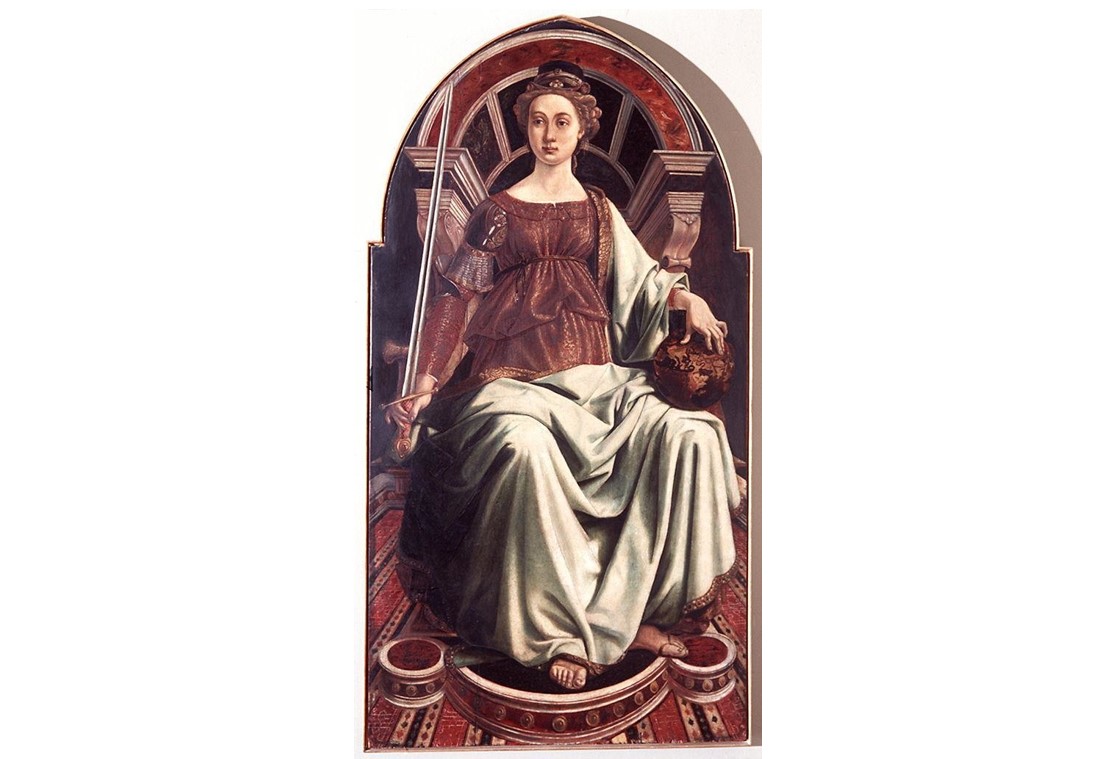+39 0669887260 | info@wucwo.org | Contact us
Art for meditation - May 2024

Piero del Pollaiolo (Florence 1441 - Rome 1496), Justice, 1469-72, tempera grassa on panel, 168 x 90.5 cm, Florence, Museo degli Uffizi
The Virtues: Justice.
Last April, Pope Francis - who has dedicated all of this year's general audiences to the vices and virtues - spoke about the second of the 'cardinal' virtues, Justice, in his Wednesday 3 April audience.
He began his catechesis by saying that justice ‘is the social virtue par excellence. The Catechism of the Catholic Church defines it thus: “The moral virtue that consists in the constant and firm will to give their due to God and neighbor” (no. 1807). This is justice. Often, when justice is mentioned, the motto that represents it is also quoted: 'unicuique suum', that is, “may all get their due”. It is the virtue of law, which seeks to regulate relations between people with equity'.
And Piero del Pollaiolo, in the cycle dedicated to the virtues that have accompanied us in these months, wanted to paint this "cardinal" virtue with particular attention, probably because the panels were commissioned to him by a court, the Tribunale di Mercanzia, a place where justice was administered.
Once again, the virtue of Justice is a young woman and she is holding a sword in her right hand with the tip pointing upwards. Instead, the left hand is placed on a globe resting on the woman's knee, representing the world, which is also the sphere in which Justice is called to exercise her function. The clothing is very refined and elegant: the robe is woven in gold and the grey-green cloak, with its beautiful folds and the play of light it creates, seems to give the body consistency. Nothing is left to chance, every detail is taken care of, be it the niche or the base of the throne on which Justice sits, or the carpet that covers the floor, or the little diadem with which her curly hair is gathered.
If we have a closer look at the right arm, whose hand holds the sword, we notice that above the robe there are two pieces of armour, namely the couter (which was an articulated joint of the armour that protected the elbow and thus allowed the movement of the forearm) and the pauldron (which was the part of the armour designed to protect the shoulder). By the 14th century, the use of armed elements to represent justice was well established in the decorative arts.. Perhaps the intention was to emphasise the way in which the certainty of penalties could lead to peace and good governance, but it could also point to the importance of the just exercise of power, aimed at allowing everyone - regardless of social position, wealth, or political status - to have access to a fair process.
You shall appoint judges and officials throughout your tribes to administer true justice for the people in all the communities which the LORD, your God, is giving you. You shall not distort justice; you must be impartial. You shall not take a bribe; for a bribe blinds the eyes even of the wise and twists the words even of the just. Justice and justice alone shall be your aim, that you may have life and may possess the land which the LORD, your God, is giving you. (Deuteronomy 16, 18-20)
I proclaimed the saving justice of Yahweh in the great assembly. See, I will not hold my tongue, as you well know. I have not kept your saving justice locked in the depths of my heart, but have spoken of your constancy and saving help. I have made no secret of your faithful and steadfast love, in the great assembly. (Psalm 40, 9-10)
But a shoot shall sprout from the stump of Jesse, and from his roots a bud shall blossom…
… He shall judge the poor with justice, and decide aright for the land's afflicted. He shall strike the ruthless with the rod of his mouth, and with the breath of his lips he shall slay the wicked. Justice shall be the band around his waist, and faithfulness a belt upon his hips. (Isaiah 11, 1;4-5)
The Lord said, "Pay attention to what the dishonest judge says. Will not God then secure the rights of his chosen ones who call out to him day and night? Will he be slow to answer them? I tell you, he will see to it that justice is done for them speedily. But when the Son of Man comes, will he find faith on earth?" (Luke 18, 6-8)
In this way, the children of God and the children of the devil are made plain; no one who fails to act in righteousness belongs to God, nor anyone who does not love his brother. (1 John 3, 10)
(Contribution by Vito Pongolini)